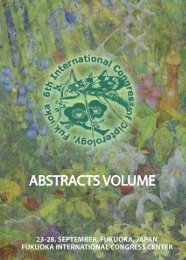Fly Times Issue 48, April 2012 - North American Dipterists Society
Fly Times Issue 48, April 2012 - North American Dipterists Society
Fly Times Issue 48, April 2012 - North American Dipterists Society
You also want an ePaper? Increase the reach of your titles
YUMPU automatically turns print PDFs into web optimized ePapers that Google loves.
12<br />
photographic illumination setup. After these tests it was set aside and allowed to dry for approximately<br />
6 weeks. The appearance of the fly eye prior to attempting re-hydration is shown in Figure 2, and after<br />
a 10 minutes soak in Figure 3 and after a 1 hour soak in Figure 4. The 1 hour soak was quite successful.<br />
Figures 4 and 5 illustrate the restoration of the green eye color. Also visible are the subtle stripes often<br />
found in Dolichopodidae.<br />
Fig. 3 (left). Condylostylus after 1 hour soak in warm soapy water. Fig. 4 (right). One<br />
hour after removal from 1 hr soak.<br />
Since it was expected that a larger insect would<br />
require longer immersion, the same fly was tested<br />
with a 2 hour soak to determine if the longer soak<br />
would damage the eye. This test was performed<br />
one day after the one hour soak. The fly's eye had<br />
started to become dehydrated and the appearance<br />
prior to the 2-hour soak is shown in Figure 6.<br />
Soaking for an additional 2 hours produced no<br />
obvious damage. Again the specimen was rinsed<br />
and blotted. Figures 7 and 8 illustrate the<br />
appearance after the test. It should be pointed out<br />
that the eye started to develop speckles, a possible<br />
precursor to mold ().<br />
Fig. 5. Condylostylus prior to 2 hour soak<br />
Fig. 6 (right). Condylostylus immediately after 2 hour soak. Fig. 7. 45 minutes after 2 hour soak
















